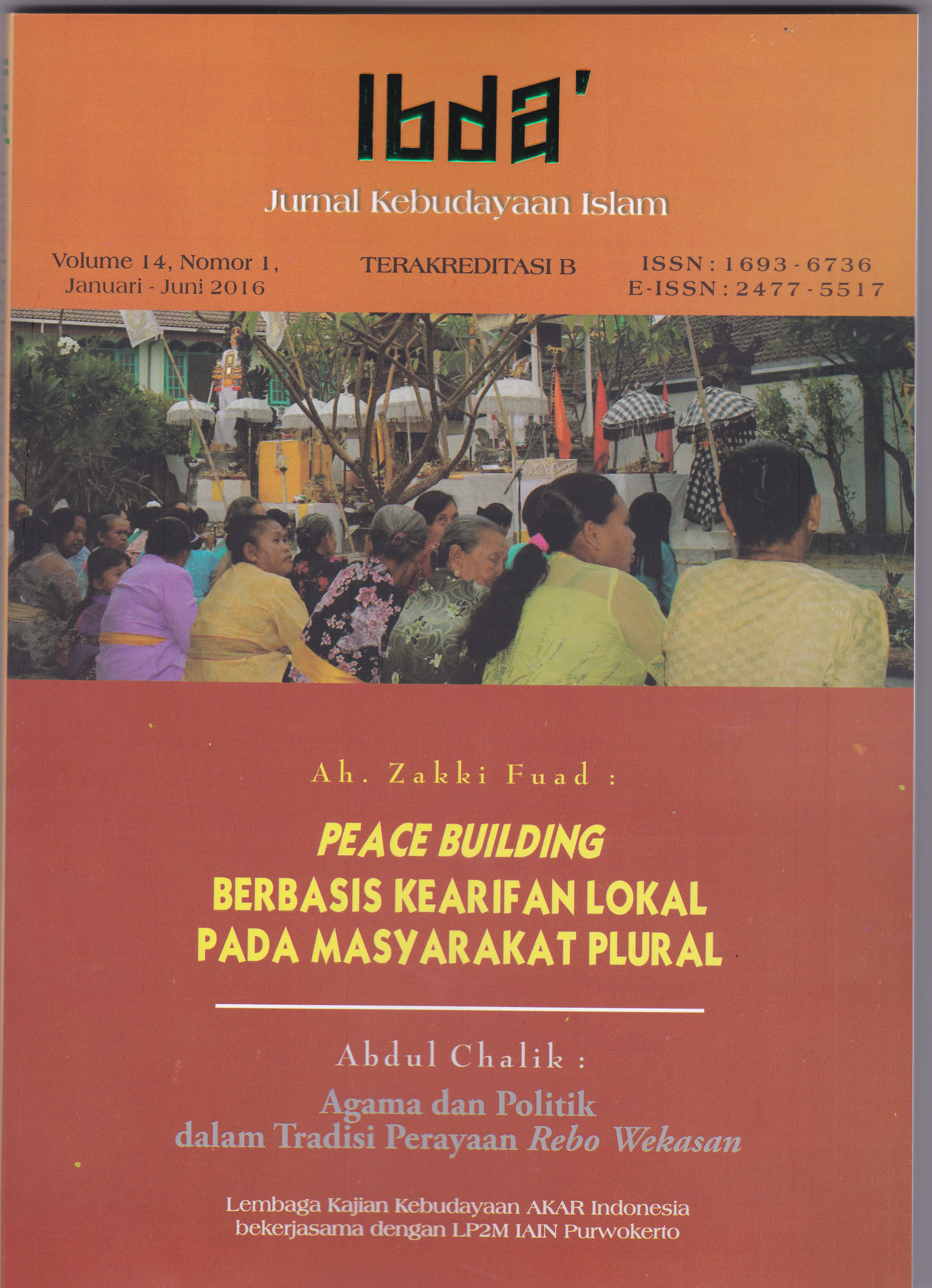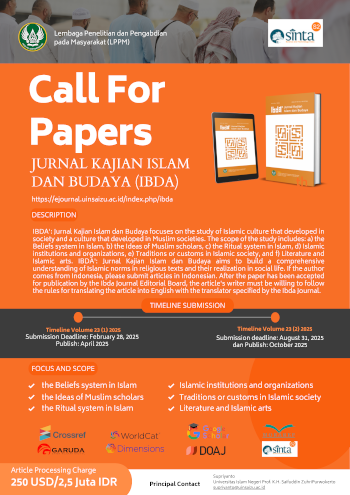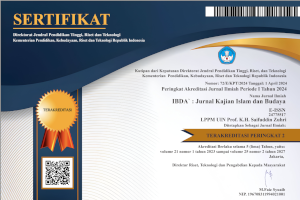JILBAB: BUDAYA POP DAN IDENTITAS MUSLIM DI INDONESIA
DOI:
https://doi.org/10.24090/ibda.v14i1.623Keywords:
jilbab, budaya pop, identitas, muslim Indonesia, ambivalensi,Abstract
The purpose of this study is to examine jilbab as a pop culture and Indonesian moslem identity. The use of jilbab (a headscarf or a head covering) for moslem women has gained its popularity since the last twenty year. This phenomenon is interesting to be investigated particularly from diverse jilbab or veiling practices in many different ways. Indonesian moslem women, for instance, used styles of jilbab and fashion which are different from those worn by moslem women in other countries. Hence, this shows characteristics of Indonesian moslem women in wearing or using jilbab which becomes an identity. Many scholars see identity as a product of social construction, and a fluid concept. This is due to the emergence of various identities resulted from different contexts. For the theoretical framework, this study uses Barthes semiotic analysis to interpret and decode the signs attached to jilbab and Indonesian moslem fashion as a part of pop culture and a new identity. The result of the study indicates that jilbab as a headscarf changes from time to time in terms of its use and styles. Jilbab styles worn by Indonesian moslem women adopted both local and global styles. This demonstrates the hybrid identity of Indonesian moslem women in wearing or using jilbab.Downloads
Download data is not yet available.
References
Barnard, Malcolm.2011. Fashion sebagai Komunikasi: Cara Mengomunikasikan Identitas Sosial, Seksual, Kelas, dan Gender. Yogyakarta: Jalasutra.
Barthes, Roland. 1983. The Fashion Sistem. New York: Hill and Wang
Barthes, Roland. 2007. Petualangan Semiologi. Yogyakarta: Pustaka Pelajar.
Candraningrum, Dewi. 2013. Negotiating Women’s Veiling: Politics and Sexuality in Contempotary Indonesia. Bangkok, Thailand: Irasec.
Chaney, David. 1996. Lifestyles: Sebuah Pengantar Komprehensif. Yogyakarta: Jalasutra.
El Guindi, Fadwal. 200l3. Jilbab: Antara Kesalehan, Kesopanan, dan Perlawanan. Jakarta: Serambi.
Hadi, Solichul. 2006. Jilbab Funky tapi Syar’i. Yogyakarta: Diwan.
Hamdani, Deny. 2011. Anatomy of Muslim Veils: Practice, Discourse and Changing Appearance of Indonesian Women. LAMBERT Academic Publishing.
Hardiyanti, Rima. 2012. “Komunitas Jilbab Kontemporer “Hijabers†di Kota Makasarâ€. Skripsi. Fakultas Ilmu Sosial dan Ilmu Politik. Universitas Hasanudin. Makasar. (tidak dipublikasikan).
Heryanto, Ariel (ed). 2012. Budaya Populer di Indonesia: Mencairnya Identitas Pasca-Orde Baru. Yogyakarta: Jalasutra.
Ibrahim, Idi Subandy. 2011a. Budaya Populer sebagai Komunikasi: Dinamika Popscape dan Mediascape di Indonesia Kontemporer. Yogyakarta: Jalasutra.
Ibrahim, Idi Subandy. 2011b. “Pakaian Anda Menunjukkan Siapa Anda? Semiotika Fashion sebagai Komunikasi Artifaktua†dalam Fashion sebagai Komunikasi. Yogyakarta: Jalasutra.
Prasetia, Heru. 2009. “Pakaian, Gaya, dan Identitas Perempuan Islamâ€. Jurnal Srinthil Edisi 17. Depok.
Raleigh, Elizabeth. 2004. “Busana Muslim dan Kebudayaan Populer di Indonesia: Pengaruh dan Persepsiâ€. Skripsi Universitas Muhamadyah Malang. (tidak dipublikasikan)
Strinati, Dominic. 2007. Populer Culture: Pengantar Menuju Teori Budaya Populer. Yogyakarta: Jejak.
Storey, John. 2007. Cultural Studies dan Kajian Budaya Pop: Pengantar Komprehensif Teori dan Metode. Yogyakarta: Jalasutra.
Zoest, Aart van. 1993. Semiotika: Tentang Tanda, Cara Kerjanya dan Apa yang Kita Lakukan Dengannya. Jakarta: Yayasan Sumber Agung.
Barthes, Roland. 1983. The Fashion Sistem. New York: Hill and Wang
Barthes, Roland. 2007. Petualangan Semiologi. Yogyakarta: Pustaka Pelajar.
Candraningrum, Dewi. 2013. Negotiating Women’s Veiling: Politics and Sexuality in Contempotary Indonesia. Bangkok, Thailand: Irasec.
Chaney, David. 1996. Lifestyles: Sebuah Pengantar Komprehensif. Yogyakarta: Jalasutra.
El Guindi, Fadwal. 200l3. Jilbab: Antara Kesalehan, Kesopanan, dan Perlawanan. Jakarta: Serambi.
Hadi, Solichul. 2006. Jilbab Funky tapi Syar’i. Yogyakarta: Diwan.
Hamdani, Deny. 2011. Anatomy of Muslim Veils: Practice, Discourse and Changing Appearance of Indonesian Women. LAMBERT Academic Publishing.
Hardiyanti, Rima. 2012. “Komunitas Jilbab Kontemporer “Hijabers†di Kota Makasarâ€. Skripsi. Fakultas Ilmu Sosial dan Ilmu Politik. Universitas Hasanudin. Makasar. (tidak dipublikasikan).
Heryanto, Ariel (ed). 2012. Budaya Populer di Indonesia: Mencairnya Identitas Pasca-Orde Baru. Yogyakarta: Jalasutra.
Ibrahim, Idi Subandy. 2011a. Budaya Populer sebagai Komunikasi: Dinamika Popscape dan Mediascape di Indonesia Kontemporer. Yogyakarta: Jalasutra.
Ibrahim, Idi Subandy. 2011b. “Pakaian Anda Menunjukkan Siapa Anda? Semiotika Fashion sebagai Komunikasi Artifaktua†dalam Fashion sebagai Komunikasi. Yogyakarta: Jalasutra.
Prasetia, Heru. 2009. “Pakaian, Gaya, dan Identitas Perempuan Islamâ€. Jurnal Srinthil Edisi 17. Depok.
Raleigh, Elizabeth. 2004. “Busana Muslim dan Kebudayaan Populer di Indonesia: Pengaruh dan Persepsiâ€. Skripsi Universitas Muhamadyah Malang. (tidak dipublikasikan)
Strinati, Dominic. 2007. Populer Culture: Pengantar Menuju Teori Budaya Populer. Yogyakarta: Jejak.
Storey, John. 2007. Cultural Studies dan Kajian Budaya Pop: Pengantar Komprehensif Teori dan Metode. Yogyakarta: Jalasutra.
Zoest, Aart van. 1993. Semiotika: Tentang Tanda, Cara Kerjanya dan Apa yang Kita Lakukan Dengannya. Jakarta: Yayasan Sumber Agung.
Downloads
Published
2016-05-30
How to Cite
Meilinawati, L. (2016). JILBAB: BUDAYA POP DAN IDENTITAS MUSLIM DI INDONESIA. IBDA` : Jurnal Kajian Islam Dan Budaya, 14(1), 139–155. https://doi.org/10.24090/ibda.v14i1.623
Issue
Section
Articles
License
Authors who publish with this journal agree to the following terms:
- Authors retain copyright and grant the journal right of first publication with the work simultaneously licensed under a Creative Commons Attribution-ShareAlike License a that allows others to share the work with an acknowledgement of the work's authorship and initial publication in this journal.
- Authors are able to enter into separate, additional contractual arrangements for the non-exclusive distribution of the journal's published version of the work (e.g., post it to an institutional repository or publish it in a book), with an acknowledgment of its initial publication in this journal.
- Authors are permitted and encouraged to post their work online (e.g., in institutional repositories or on their website) before and during the submission process, as it can lead to productive exchanges, as well as earlier and greater citation of published work (See The Effect of Open Access).
















